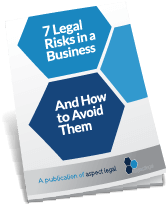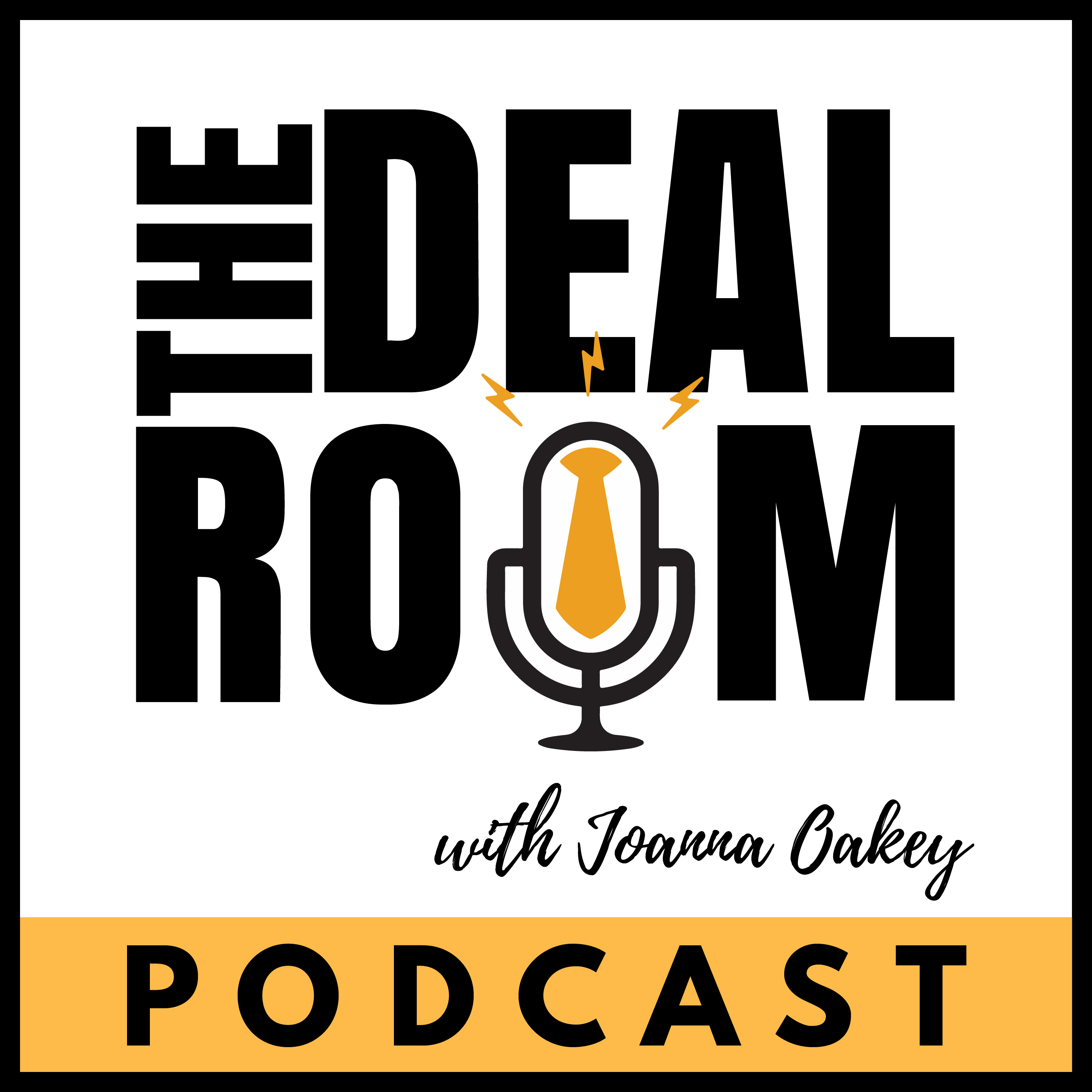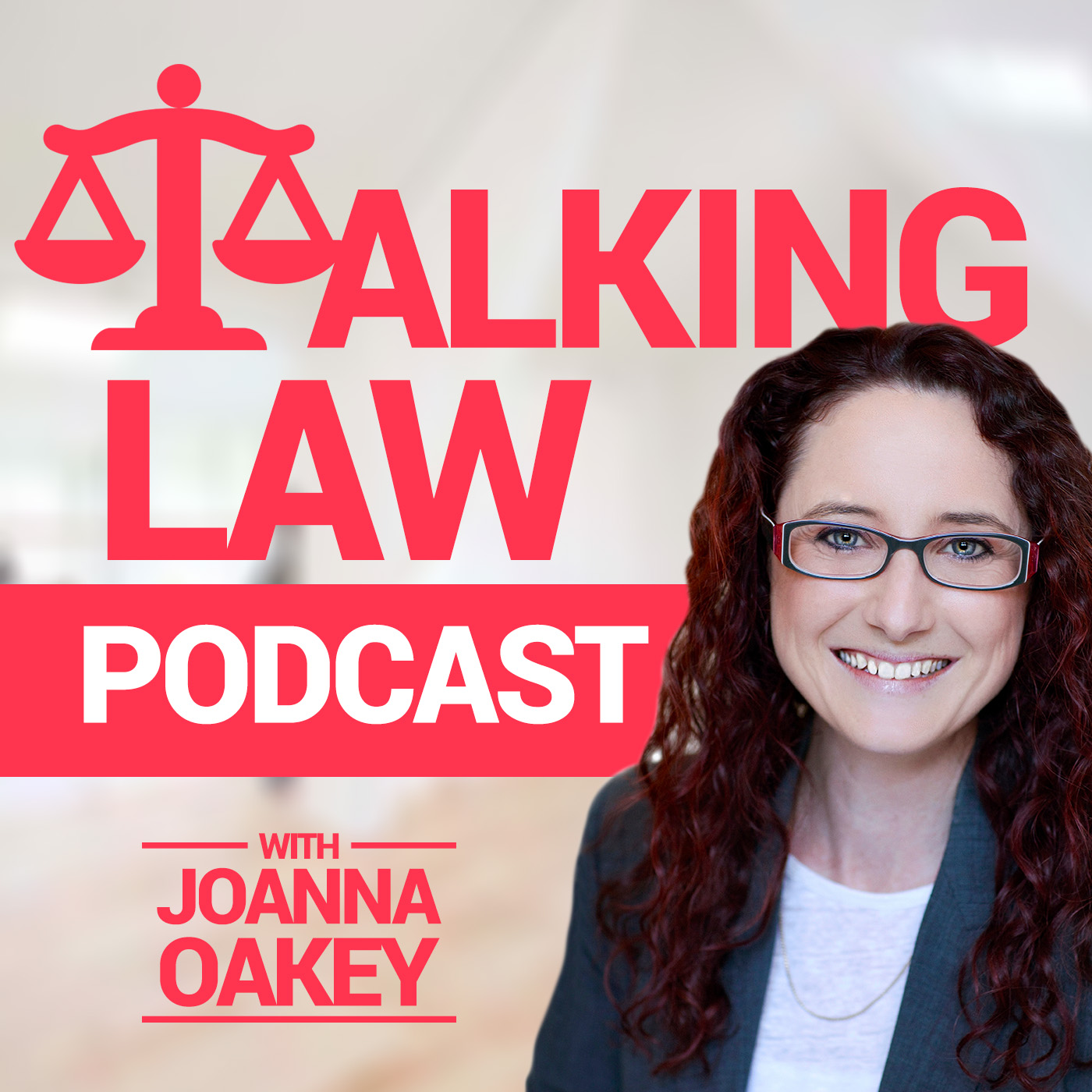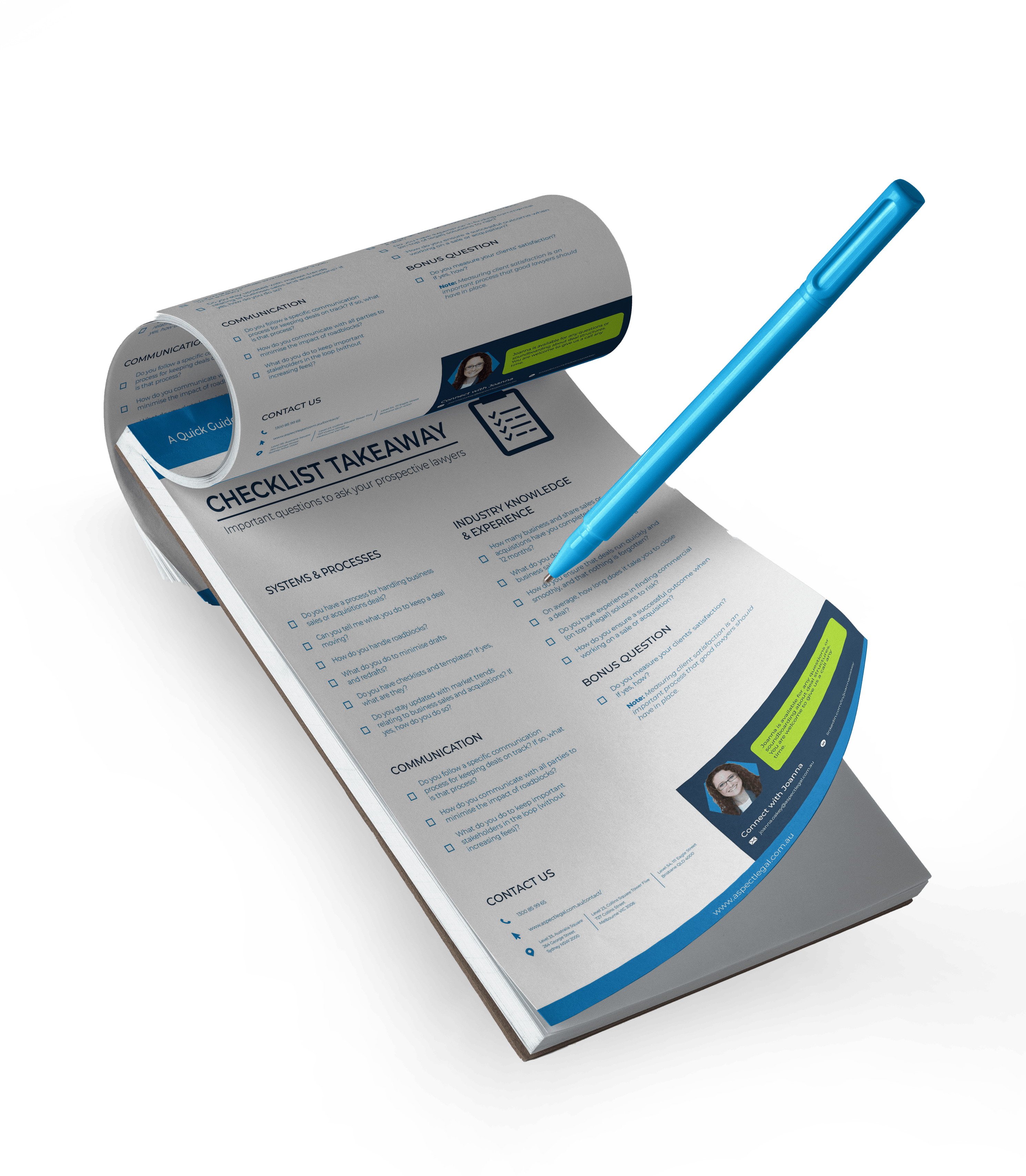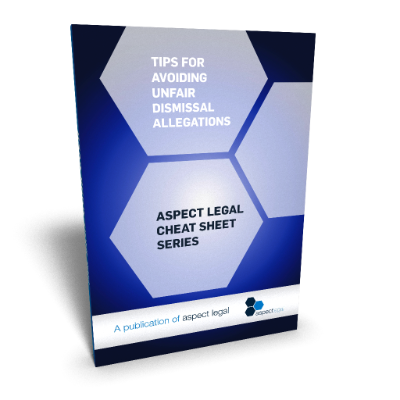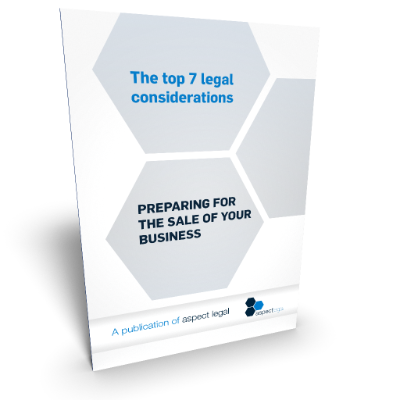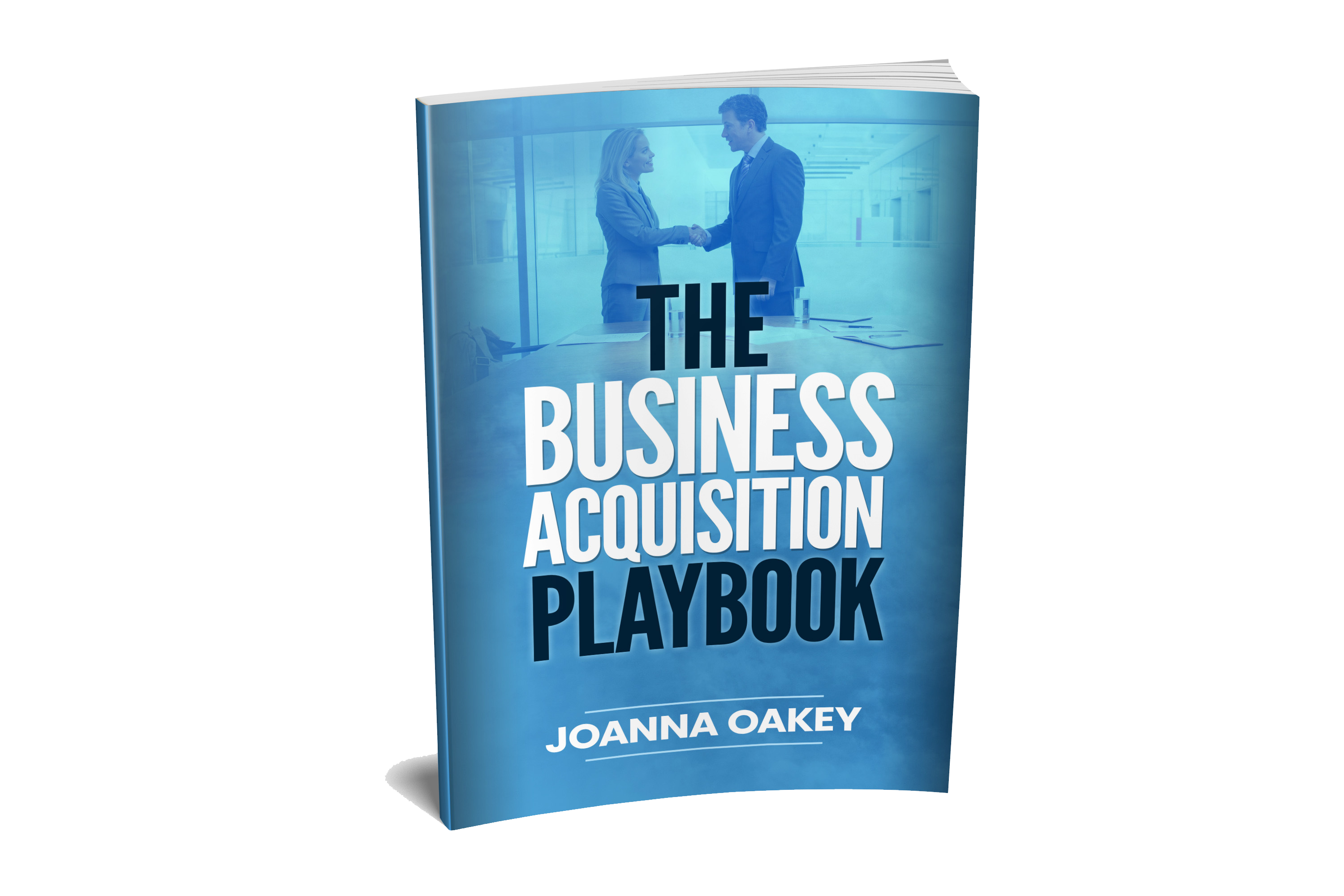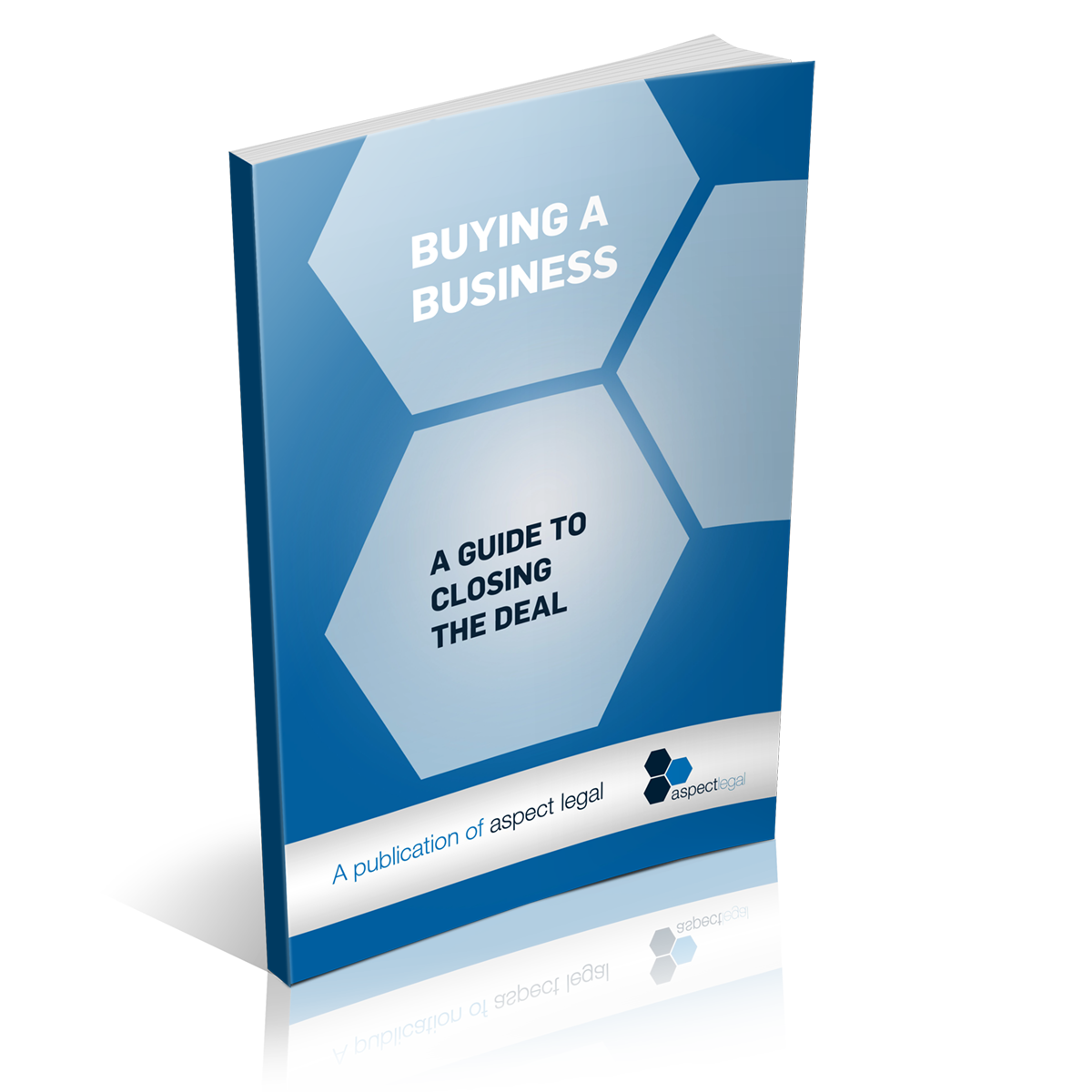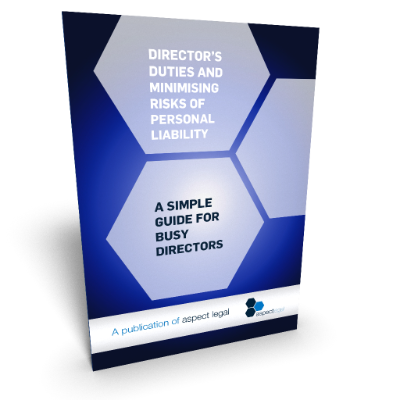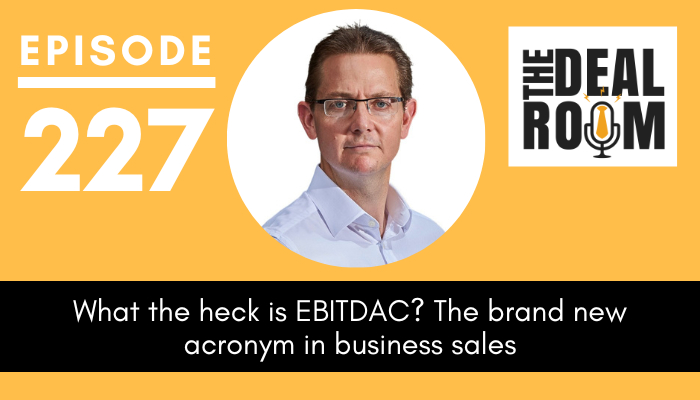
Today we have on the show, Cameron Ryan from Xcllusive Business Brokers talking about an interesting new term – EBITDAC. What is EBITDAC you say…? Cameron and our host Joanna Oakey dig into this concept and how it may be relevant to you and your business.
Cameron comes to us with a history in business broking spanning all the way back to 2009. He has a Bachelor of Commerce, a graduate diploma in Applied Finance and Investment and is a registered Business Valuer and Certified Practicing Business Broker with the Australian Institute of Business Brokers. AND…with the last few years added to his experience list, he is certainly more than qualified to talk to us about this new topic.

Episode Highlights:
- What is EBITDAC? And where did this term come from?
- The importance of normalisation of your accounts
- A practical example of a situation where EBITDAC was used
- How buyers are reacting to business revenue fluctuations from the past couple of years
- What impact does the EBITDAC assessment have on the timing of when sellers are thinking about going to market
Connect with Cameron Ryan:
Book a 15-min FREE initial consultation with our Legal Eagles!
Leave us a review:
iTunes: https://podcasts.apple.com/ph/podcast/the-deal-room/id1267098895
Transcript below!
Note: This has been automatically transcribed so will be full of errors! We are not providing it to you as a word-perfect version of the podcast but just as an easy way to provide you with a different way to be able to scan for information that might be relevant to you.
Joanna:
Hi, it’s Joanna Oakey here and welcome back to The Deal Room podcast, a podcast proudly brought to you by our commercial legal practice aspect legal now today we have on the show, Cameron Ryan from Xcllusive Business Brokers talking all about an interesting new term of EBITDAC, EBITDAC you say? What in heck is this? Well, Cameron and I dig into the concept of EBITDAC in this episode. Now, Cameron comes to us with a history in business broking spanning all the way back to 2009. He has a Bachelor of Commerce, a graduate diploma in Applied Finance and Investment and is a registered Business Valuer and Certified Practicing Business Broker with the Australian Institute of Business Brokers. Now that was a mouthful, wasn’t it? So he is certainly more than qualified to talk to us about this new topic today of this new headline, EBITDAC, so in order to drill into EBITDAC, what it is and how it’s relevant for you, your business sale and your business valuations, buckle in right now, as we investigate it all with Cameron, here we go.
Joanna:
Cameron huge thank you for coming on to The Deal Room podcast today. It’s so good to see you.
Cameron:
Thanks so much for having me.
Joanna:
Wonderful. Now, of course, we are talking about an interesting topic today, EBITDAC. Now, we’ve all heard of EBITDA, or EBIT, but EBITDAC, I’ve never heard of. And you mentioned this term, in fact, at a conference recently with a group of brokers, and I heard that term and I thought, goodness gracious me, I must have Cameron come on to the podcast and talk to us about EBITDAC. What is EBITDAC? And where did this come from?
Cameron:
Yes, certainly. EBITDA is a term that we’re very familiar with in the business valuation and business brokerage space, earnings before interest, tax depreciation, amortization, something that we use as a measurement of how our business has performed over a period of time. We make adjustments depending on what’s on profit and loss statement for a particular business to come up with normalized EBITDA to take out any abnormal or non business related expenses or income.
Joanna:
Okay? Now, I’m going to stop there for a moment. Because I know you’re talking about what EBIT DA is, is an intro into EBITDAC. But I just want to drill in on a couple of things that so the normalization, I think it’s a really good point that you’re making right here, you know, bringing up normalization of accounts, because I find that many sellers don’t really understand that this is something that will happen to their accounts, or that needs to happen to their accounts, prior to going on to the market. And from a buy side, I often find buyers, you know, who haven’t run this gauntlet before, maybe you don’t fully understand what that adjustment to the account mean. So can you just step us through this super quick just in, you know, a couple of a couple of ideas like what’s an example of what we’re doing when we’re normalizing the accounts?
Cameron:
Yes, certainly. So the financial statements for a business will present the profit and loss statement, as has been recorded. And often it includes non business related or non core income and expenses. So These might be things such as foreign currency gains or losses, profit and loss on sale of non current asset, you might have donations that have been made through the business, you might have fines and penalties, you might have one off expenses. So if you upgrade your computer system, you might see your computer expenses for a particular year increased dramatically, but then dropped down to a normal amount. So when we look at EBITDA over a period of time, per the profit and loss statements provided by the vendor or the vendor’s accountant, we need to make adjustments, so either deductions or additions to adjust for these abnormal or non business related income and expenses to determine what you would call the true profitability of that business, excluding those abnormal income and expenses. So and that’s what we refer to an industry is normalized earnings or normalized EBITDA.
Joanna:
Brilliant, thank you Cameron. Now you can continue. I just wanted to drill into that a bit more, because I think it’s useful. It’s interesting, good information. Sorry, continue. So usually, we then have our normalized account.
Cameron:
Yeah, so we come up with normalized. And traditionally, that’s just what we’ve used, whether you’re looking at a profit loss statement monthly, quarterly, or annually. It allows for all those abnormal or non core income expenses to be adjusted for what I’ve been seeing through these unprecedented times. And now that we’re at the back of COVID, what we’re seeing is that post COVID, during which we’ve undergone two years of quite unprecedented times, is that we’re seeing profit and loss statements and certain businesses and certainly industries that have been affected by COVID. In one way or another, some businesses and industries have thrived and really seen a significant uplift during COVID others have been decimated. They’ve seen a huge hit to their revenues and therefore their profitability. Talking with a couple of accountants. And what we’ve started to discuss is this term of EBITDAC. So Earnings Before Interest, Tax, Depreciation, Amortization and COVID.
Joanna:
That is so good and COVID. Love it. Love it. Sorry, I just had to stop. That was too funny. Okay, continue.
Cameron:
When I first heard that term, I also had a reaction like you did, I laughed and thought, well, that sounds ridiculous. But the more businesses that I’m looking at now that we’re doing appraisals for and that we’re doing business valuations for, the more appropriate I’m starting to think the term EBITDAC becomes there is a time period. So effectively, we’ve had the last quarter of FY 20. The entire financial year ended 30 June 2021. And effectively the first two quarters of FY 22 impacted by COVID. During this time, we’ve had In different trading conditions, depending on what your business is doing, we’ve seen huge government stimulus packages and government grants. And we’ve seen a huge variation, certain costs. So a good example is the cost of bringing a shipping container into the country went up significantly during COVID. And now it’s come back down. What I’m seeing is for that time period, so roughly last quarter of FY 2020, through the quarter to of FY 2022. There is a huge knock calling, but it becomes very appropriate to start to look at this term EBIT deck. An example that I was, I thought was probably worthwhile mentioning or bringing up is a business that I’ve had on the books for a while. And it’s the importer and distributor of vaccine and medical fridges and freezers. This business was started seven years ago, so well before COVID. And it’s got some very reliable trading statements from that pre COVID time. But as you can imagine, when COVID hit vaccine, fridge and freezer sales went through the roof. So what I’m seeing is when I analyze his figures now, and I look at the specially for FY 21. So the 12 months ended 30 June 2021, he has had a one off year during which revenues were up about 250% on the year before. And then in FY 22, we’ve seen that revenues drop back again, this is a good example of where I think that the presentation of an EBITDAC will become very relevant when putting that business to the marketplace and trying to explain to a buyer or demonstrate to a buyer, what the true earnings were during that period. So by calculating calculating an EBITDAC, I’m actually going to take out about 25% of the revenue from that FY 21 year, because it’s a one off, and it’s not appropriate to have it in there when formulating or coming up with what you might call normalized earnings, and trying to develop an average over a three or four year period.
Joanna:
It’s fascinating actually, because most most transaction menu transactions come to us after this Argy bargy in relation to the figures is done. So it’s it’s, you know, I love sort of looking at where we are in terms of what people are seeing right now, in that, you know, valuation side. So valuation is the first and then or appraisal, and then that RG park boundary between the buyer and the seller in relation to what the you know, what their expectations are of the business moving forward, and therefore, you know, a fair value for the business and how the pay the terms of that sale will happen is that, you know, all upfront or do we have deferred payments, because we have a concern about what the future profitability or revenue in the business might be? So it’s great to hear what’s going on right now. I’m really interested, I guess you’ve talked about this from the perspective of when you’re prepping. When you’re prepping a business for the for the market in terms of looking at the figures and looking at what you’re going to lease the business at? How How are you finding that negotiation point at the moment between buyers and sellers, you know, how a buyers reacting to the the uncertainty of figures because of this fluctuation of volatility in in the performance of the business through revenue or profit over the past couple of years?
Cameron:
Yeah, again, I think we’re in a situation right now. So like we referred to before, we’re at the back end of COVID. Hopefully, we genuinely hope it’s behind us. So buyers are rightfully coming to us. And I guess analyzing a set of figures and doing what I’m trying to do. And that’s actually come up with an EBITDAC figure whereby they can make a reasonable assessment of what the business might do going forward during the period of COVID, which last every bit of 18 months, I formed the opinion, I think it’s sort of holding true that we will need at least six if not 12 months of post COVID trade to take place before we get a feel for where a business has ended up post COVID. We’re now about six months into that, I think it’s going to be at least another six months until we can present a set of figures to potential buyers for a subject business with some post COVID trade behind them, which can demonstrate the businesses kind of picked up where it left off pre COVID Or it’s improved or it’s hesitant or it’s gone backwards. But you’re again with that vaccine, fridge and freezer business. I’m almost inclined to completely ignore FY 21 Because when we look at FY 19, 20 And then 22 You actually can see the trend which looks quite reasonable and quite normal. and it takes out that that year of COVID trade where vaccine fridges were in huge demand. And it, in my opinion presents a more reasonable set of figures to the marketplace for them to assess. Again, it’s all tied around this, rather than presenting an EBIT da presenting an EBITDAC , and explaining why. And this this EBITDAC notion in five years from now, we won’t be talking about it, because hopefully it’s not relevant. But right now, and I think for the next probably 12 or 24 months, when we are looking at trading conditions and profit and loss statements during FY 2021 and 22, which are all impacted by COVID. I think this EBITDAC notion or term has a real place.
Joanna:
So good. And I love that we have a name for it now, because you’re absolutely right. It’s clearly happening out in the market in terms of buyers coming in and needing to come up with, you know, their assessment of the value of the business, EBITDAC. There we go. We’ve got a name for it now. But just before we leave, but just I’ve got a couple of very quick questions. What impact? Do you think that this assessment of yours in relation to you know, the fact that we’re probably still six months away from being able to see more a more normal trend within businesses in terms of weather up to for a valuation perspective? What impact do you think this has or should have, on the timing of when sellers are thinking about going to market?
Cameron:
I think it assists because vendors or sellers will be in a position where you can present a set of figures to the market, taking out the fluctuations, the impacts of COVID, it might little be a little bit arbitrary at times. But if you set for the assumptions being made, and why you have or haven’t excluded some income, or you have or haven’t excluded some costs, I think that calculation would be but debt can be reasonably supported. And it allows it will allow a vendor to get their business to market now rather than in six or 12 months time once they’ve got that post COVID trade behind.
Joanna:
Such a good point. And I guess just on the buyer side, does that have any impact on the timing of acquisitions as well?
Cameron:
I don’t think so. Buyers, what I’m finding at the moment buyers are out there. They’re wanting to transact based on their own personal situations, or the group that they’re acting for. They just need to make sense of the numbers today, based on what the business has done. Again, I think, as a broker presenting figures on behalf of the vendor, to present a realistic figures, set of figures with an EBIT deck calculation actually assists the buyer and makes the process more transparent, because you’re not trying to sell the business off the back of inflated COVID figures if the business has actually seen uplift. But you’re also reasonably not trying to sell the business based on some poor trading conditions if they are impacted by COVID. So I think it’s a fair and reasonable way to look at it for both the buyer and the seller, and work through what was this, you know, this unique set of circumstances that is COVID and trying to present a set of figures that takes the impact of COVID negative or positive out of the equation.
Joanna:
And allows them to transact now rather than waiting for six to 12 months as we say.
Cameron:
Exactly.
Joanna:
Love it. Cameron EBITDAC you’ve heard it here first. Well, maybe you haven’t. Maybe you’ve heard it somewhere else. I don’t think I have. I haven’t heard her around before. I love it.
Joanna:
Cameron, what a great title. Cameron huge thank you for coming onto the show. If any of our listeners want to get in contact with you, how do they do that?
Cameron:
Yes, certainly. I am a broker with a group called Xcllusive Business Sales. They could contact the Sydney head office. Just contact details on the website which is Xcllusive.com.au
Joanna:
And of course we’ll link through to that Cameron in our show notes. Now, if you are running along the beach right now and can’t haven’t been able to write that down. Fair enough. Good plan, healthy you but you’ll be able to find it in your show notes on your podcast player, or over at our website, thedealroompodcast.com. Cameron, thank you so much for joining us on the show today.
Cameron:
Thanks for having me Jo.
Joanna:
Well that’s it for our episode today with Cameron Ryan from Xcllusive Business Brokers, talking all about this new terminology EBITDAC! Fabulous. I love a bit of innovation in the industry. This sounds a bit innovative to me a whole new terminology, a whole new acronym that we have to work with. So if you want to find out more about this topic, or get a transcript of the podcast episode in full detail, or if you want to link straight through to Cameron and exclusive Business Brokers then head over to our website at www.the dealroompodcast.com.au. and as I say there you’ll be able to find the contact details for Cameron at Xcllusive Business Brokers and on that website, you will also be able to find details for how you can book in a free initial call with our Legal Eagles at Aspect Legal to find out how we might be able to assist you or your buyer’s or seller’s with their acquisition or sale. We have an number of great services for both small and large deals, and we’d love to be able to assist well that’s it i really hope you enjoyed what you heard today. If you did, please don’t be shy in heading to the reviews page and leaving us a bit of a review. We’d be ever so grateful. And while you’re there don’t forget to hit the subscribe button. Alright, well that’s it you’ve been listening to Joanna Oakey and The Deal Room podcast, a podcast proudly brought to you by our commercial legal practice Aspect Legal. See you next time.
Our Business Sales and Growth by Acquisitions Services
Aspect Legal has a number of great services that help businesses prepare for a sale or acquisition to help them prepare in advance and to get transaction ready. And we’ve also got a range of services to help guide businesses through the sale and acquisition process.
We work with clients both big and small and have different types of services depending on size and complexity. We provide a free consultation to discuss your proposed sale or acquisition – so see our show notes on how to book a time to speak with us, or head over to our website at Aspectlegal.com.au
Disclaimer: The material contained on this website is provided for general information purposes only and does not constitute legal advice. You should not depend upon any information appearing on this website without seeking legal advice. We do not guarantee that the contents of this website will be accurate, complete or up-to-date. Liability limited by a scheme approved under Professional Standards Legislation




